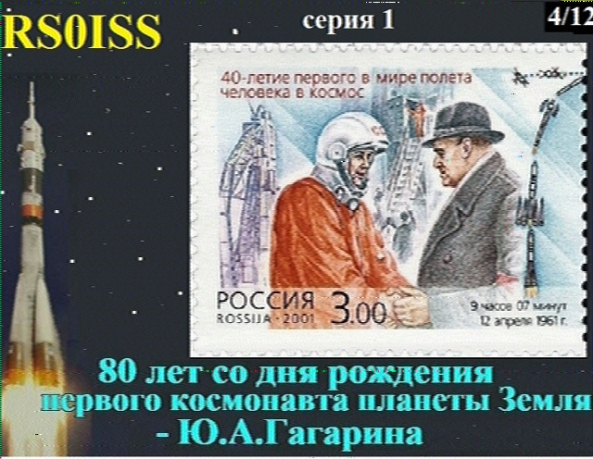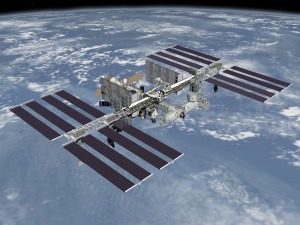Slow Scan Television (SSTV) is transmitted by the ARISS Russia Team from the amateur radio station in the Russian Service Module of the International Space Station using the callsign RS0ISS. The equipment used is a Kenwood D710 transceiver running about 25 watts output which provides a very strong signal enabling reception using simple equipment.
In the past twelve different images were sent on 145.800 MHz FM using the SSTV mode PD180, with a 3-minute off time between each image. This has now changed to use the faster PD120 mode with a 2 minute off-time which will allow more images to be received in an orbital pass.
The images received by amateurs world-wide during previous transmissions can be seen at http://www.spaceflightsoftware.com/ARISS_SSTV/ and you are invited to upload any pictures you receive during the upcoming transmissions.
In the UK newspaper the Daily Mail, Jonathan O’Callaghan wrote about how 22-year-old Radek Karwacki, an AMSAT-UK member, received pictures from the ISS using a £10 ($15) RTL-SDR dongle and a dipole antenna, see https://amsat-uk.org/2015/02/04/iss-sstv-in-uk-press/
All you need to do to receive SSTV pictures direct from the space station is to connect the audio output of a scanner or amateur radio transceiver via a simple interface to the soundcard on a Windows PC or an Apple iOS device, and tune in to 145.800 MHz FM. You can even receive pictures by holding an iPhone next to the radio loudspeaker.
On Windows PC’s the free application MMSSTV can be used to decode the signal, on Apple iOS devices you can use the SSTV app for compatible modes. For Linux systems try QSSTV.
The ISS puts out a strong signal on 145.800 MHz FM and a 2m handheld with a 1/4 wave antenna will be enough to receive it. The FM transmission uses 5 kHz deviation which is standard in much of the world. In IARU Region 1 (British Isles, Europe, Africa) FM equipment is usually set by default to the narrower 2.5 kHz deviation.
Many FM rigs can be switched been wide and narrow deviation FM filters. For best results you should select the filter for wider deviation FM. Handhelds all seem to have a single wide filter fitted as standard.
During most of a pass the ISS may be more than 15 degrees above the horizon so an antenna with a high radiation angle will give better results. Simple antennas such as an outdoor ¼ wave ground plane or dipole should give good results. Large 2m colinear antennas don’t work quite as well because their radiation pattern is concentrated at the horizon.
Check the N2YO site to see when the ISS is in range https://n2yo.com/?s=25544&df=1
Read ISS SSTV Video and “ISS SSTV Reception Hints” by John Brier KG4AKV at https://spacecomms.wordpress.com/iss-sstv-reception-hints/
Watch PD180 SSTV Test Recording by John Brier KG4AKV
MP3 test recording of a PD120 transmission by John Brier KG4AKV
MP3 test recording of a PD180 transmission by John Brier KG4AKV
Paul Turner G4IJE, co-developer of the SSTV PD modes, says regarding the MMSSTV PD180 mode: “Don’t forget to either enable “Always show RX viewer” or use the “Picture viewer” (magnifying glass icon) to show the picture at its real resolution of 640 x 496. If you just view as normal you will only see 320 x 248 resolution, which kind of defeats the object of using a high resolution mode.”
On the AMSAT-BB Rick W2JAZ and Alan WA4SCA comment on the need to set the MMSSTV sound card setting to 48 kHz instead of the default 44.100 kHz
• Options
• Setup
• Misc
• Then the Clock section at the bottom of the page
The MMSSTV default setting may need to be set to 24000 (exactly half of the sound card setting). You then should get good clean images.
The sound card adjustments will vary slightly depending on the version of the OS you are running, but usually will be under the advanced properties for the device. You can probably use a higher sampling rate for the sound card so long as it is a power of 2 multiple (2,4,8, etc) of the value in MMSSTV. For instance 192k (8x) has no issues. The same applies to most similar software.
You can receive the SSTV transmissions by using an Online Radio (WebSDR) and the MMSSTV software:
• Listen to the ISS when it is in range of London with the SUWS WebSDR http://farnham-sdr.com/
• Listen to the ISS when it is over Russia with the R4UAB WebSDR http://websdr.r4uab.ru/
ISS Tracking / Predictions https://amsat-uk.org/beginners/satellite-tracking/
Free MMSSTV Slow Scan TV software http://hamsoft.ca/pages/mmsstv.php
iOS SSTV App https://itunes.apple.com/gb/app/sstv/id387910013
Linux QSSTV Linux QSSTV https://sourceforge.net/projects/qsstv/
For more on Slow Scan Television SSTV, see this article SSTV – The Basics
http://www.essexham.co.uk/sstv-the-basics
How to be successful with the ISS Slow Scan Television (SSTV) imaging system
http://www.marexmg.org/fileshtml/howtoisssstv.html
IZ8BLY Vox Recoder, enables you to record the signals from the ISS on 145.800 MHz while you’re away at work http://antoninoporcino.xoom.it/VoxRecorder/
Information on the MAI-75 SSTV experiment
http://www.energia.ru/eng/iss/researches/education-26.html
Video showing reception of SSTV using the FUNcube Dongle Pro SDR and SDR-RADIO going into Virtual Audio Cable (VAC) then to MMSSTV software https://www.youtube.com/watch?v=K6MOrX9iZCk
ISS SSTV received online with SUWS WebSDR
https://amsat-uk.org/2014/09/06/iss-sstv-on-suws-websdr/
Please note that SSTV events are dependent on other activities, schedules and crew responsibilities on the ISS and subject to change at any time. You can check for updates regarding planned operation at:
ISS Ham https://twitter.com/RF2Space
ARISS Status https://twitter.com/ARISS_status
ARISS SSTV Blog https://ariss-sstv.blogspot.com/
AMSAT Bulletin Board http://www.amsat.org/mailman/listinfo/amsat-bb
You can see SSTV images received from the ISS and upload your images at the ARISS SSTV Gallery
http://www.spaceflightsoftware.com/ARISS_SSTV/





You must be logged in to post a comment.